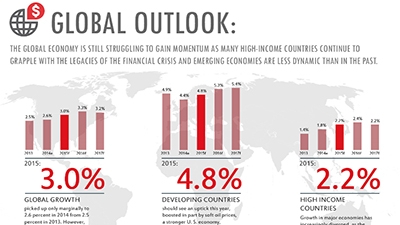Overview
Growth in the developing Europe and Central Asia region is estimated to have slowed to a lower-than-expected 2.4 percent in 2014, from 3.7 percent in 2013. This reflected a sharp contraction in Ukraine, spillovers from weakness in Russia and the Euro Area, and slowing capital inflows.
Russia’s economy slowed to 0.7 percent in 2014. Tensions with Ukraine, sanctions, and falling crude oil prices interacted with a structural slowdown, although a depreciating ruble and increased public spending supported exports and industrial production in the final quarter of 2014 after a sharp contraction in mid-2014.
Capital flight and the loss of access to international capital markets by Russian corporates under sanctions led to over 75 percent depreciation of the ruble against the U.S. dollar between January and mid-December in 2014, despite repeated interest rate hikes and interventions in the currency markets by the central bank.
Conflict has taken a severe toll on Ukraine’s economy, with output estimated to have contracted an estimated 8.2 percent in 2014. An 85 percent depreciation of the currency against the U.S. dollar in 2014 and a sharp import compression led to a significant current account adjustment.
In the Commonwealth of Independent States (CIS), growth slowed sharply to 1.5 percent, mainly attributable to the sharp output contraction in Ukraine, while Russia’s slowdown has had negative spillovers on trade and remittances. In the first half of 2014, export volumes to Russia fell more than 10 percent year on year in Kazakhstan, and by almost 20 percent in Uzbekistan. Others have been hit hard by a sharp contraction in the value of remittances in the first half of 2014. Tajikistan and the Kyrgyz Republic, where remittances from Russia represent 46 and 29 percent of GDP, respectively, are most exposed.
Growth in Central and Eastern Europe (CEE) was broadly steady in 2014, at an estimated 2.6 percent, reflecting close trade ties to struggling core Euro Area countries. Many CEE countries are in or near deflation, due to negative output gaps, significant cuts in regulated energy prices (in Bulgaria, Croatia, Czech Republic, Hungary, and FYR Macedonia), and declining food and fuel prices. Growth in Turkey was an estimated 3.1 percent in 2014, exceeding earlier expectations. Strong government spending and export growth mitigated investment and consumption weakness associated with high inflation, domestic policy uncertainties, and rising geopolitical risk.
Outlook
After the sharp deceleration in 2014, the outlook for the region is for a modest recovery, with growth averaging 3.5 percent in 2015-17, but with considerable divergence across countries. The expected 2.9 percent contraction in Russia in 2015 and gradually tightening global financial conditions are expected to be offset to some extent by a modest recovery in Euro Area demand, diminishing political tensions, and the benefits of lower international energy prices on net importers.
Ukraine’s economy faces a highly uncertain outlook, although—assuming no further escalation of tensions—activity is expected to bottom out in 2015 and gradually recover in 2016-17. Among energy-exporting CIS countries, a slowdown in emerging market trading partners (especially China and Russia) and continued weakness in crude oil and other key commodity prices are expected to reduce growth in 2015, before the onset of a recovery in 2016-17. In oil-importing CEE countries, a gradual strengthening in the Euro Area, additional monetary accommodation and a decline in international energy prices should support industrial activity and export growth. In Turkey, growth is expected to pick up to 3.5 percent in 2015 on the back of stronger private consumption, rising to 3.9 percent in 2017.
Risks
The balance of risks to the region’s outlook remains tilted to the downside. Further escalation in political tensions with Russia, persistent stagnation in the Euro Area, or a sudden tightening of global financial conditions are key downside risks to the region’s outlook. Sharp or sustained declines in commodity prices or remittance inflows from Russia—the major source of remittances to the region - represent major risks for CIS countries. Failure of the expected modest upturn in the Euro Area to materialize represents a significant risk to the outlook of CEE countries that could derail their already-weak recovery. Financial market volatility is another potential source of uncertainty for countries with large financing needs.
------------------------------------------
For the purpose of this note, the developing Europe and Central Asia region includes 21 low and middle-income countries with income of less than $12,276 GNI-per capita in 2010. This classification excludes Croatia, the Czech Republic, Estonia, Latvia, Lithuania, Poland, the Russian Federation, Slovenia, and the Slovak Republic. The list of countries for the region may differ from those contained in other World Bank documents.

